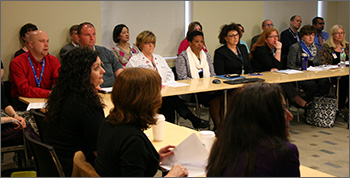
Popular Locations
- Yale New Haven Children's Hospital
- Yale New Haven Hospital - York Street Campus
- Yale New Haven Hospital - Saint Raphael Campus


Every Monday, a group of more than 60 physicians, hospital leaders and staff from different departments meets to get a global view of how well the hospital is doing on improving safety and quality.
The Patient Safety and Quality Committee (PSQC) comprises safety and quality staff from different departments and service lines, along with leaders from clinical and non-clinical areas. Thomas Balcezak, MD, chief medical officer, directs the meetings.
The PSQC keeps tabs on the numerous safety and quality improvement efforts under way throughout YNHH, hearing regular reports from 13 hospital service lines. Staff from Surgical Services, for example, recently updated the committee on efforts to integrate services across campuses, plans to open a surgical bariatric unit on Main 6 at the Saint Raphael Campus, strategies to improve the patient experience and key components of infection-reduction programs.
"Many quality and safety improvement efforts are specific to different departments," said Sally Roumanis, RN, patient safety specialist, Quality Improvement Support Services, and PSQC facilitator. "The PSQC helps ensure that department and service line improvement work is tied in with the hospital's overall performance improvement goals and high reliability efforts."
These goals, which are part of the Performance Incentive Plan (PIP), include improving catheter-associated urinary tract infection (CAUTI) rates, reducing readmissions and increasing serious safety events reporting.
Throughout the year, the PSQC also hears regular reports from charter teams of staff and leaders in various departments that are working on these and other performance improvement areas. Currently, 10 "priority level one" teams have been charged with enhancing performance to lower CAUTIs and other hospital-acquired infections, improve hand hygiene, improve patient identification and other measures. Five performance improvement teams are working to sustain gains the hospital has made in areas such as preventing patient falls and reducing pressure ulcers.
The PSQC does more than listen to reports, said Heidi Rillstone, RN, patient safety coordinator for Perioperative Services and a PSQC member. With representatives from many clinical and non-clinical areas, the committee can help the service line and charter teams in their work. For example, if a team identifies certain supplies that can help reduce infections, a PSQC member from Supply Chain can facilitate the process of bringing their request to the appropriate people.
Rillstone noted that there's a reason PSQC meetings are first thing Monday mornings.
"We start every week highlighting safety and quality work that's going on throughout the hospital," she said. "It sets the tone for everything we do that week."